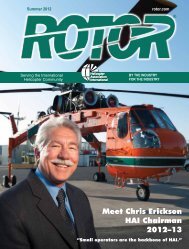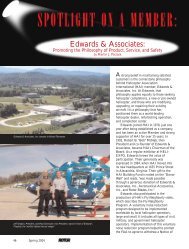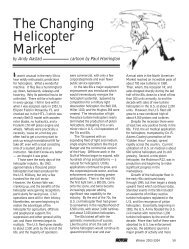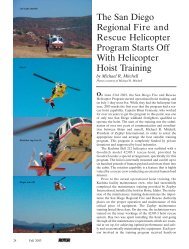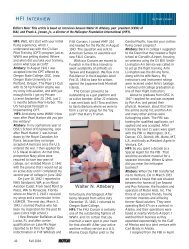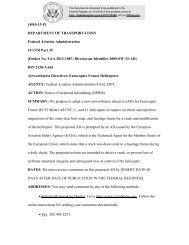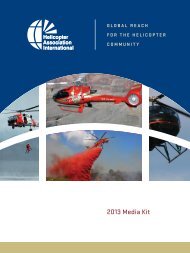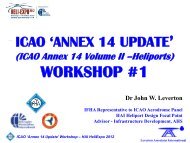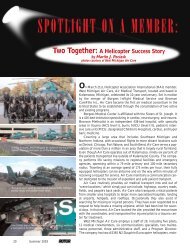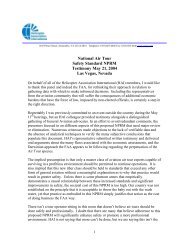Atlas and Database of Air Medical Services (ADAMS) - Helicopter ...
Atlas and Database of Air Medical Services (ADAMS) - Helicopter ...
Atlas and Database of Air Medical Services (ADAMS) - Helicopter ...
Create successful ePaper yourself
Turn your PDF publications into a flip-book with our unique Google optimized e-Paper software.
1 INTRODUCTION<br />
<strong>ADAMS</strong><br />
The “<strong>Atlas</strong> <strong>and</strong> <strong>Database</strong> <strong>of</strong> <strong>Air</strong> <strong>Medical</strong> <strong>Services</strong>” (<strong>ADAMS</strong>), is a compilation <strong>of</strong> information on air<br />
medical services in the United States who respond to the scene <strong>of</strong> a trauma or medical emergency, or who provide<br />
emergency (or scheduled) inter-hospital transport. <strong>ADAMS</strong> currently contains detailed descriptive <strong>and</strong> geographic<br />
information on air medical rotor wing (RW) <strong>and</strong> fixed wing (FW) services, including information on their corporate<br />
<strong>of</strong>fice, airport <strong>and</strong> helipad bases, communication center, rotor wing <strong>and</strong> fixed wing aircraft <strong>and</strong> the major hospitals<br />
<strong>and</strong> trauma centers which receive their emergency transports. It is believed that more than 95% <strong>of</strong> RW services <strong>and</strong><br />
90% <strong>of</strong> FW services are included in <strong>ADAMS</strong>. The <strong>ADAMS</strong> database includes all types <strong>of</strong> air medical organizations<br />
including for-pr<strong>of</strong>it <strong>and</strong> not-for pr<strong>of</strong>it, dual-use public service (police/fire), as well as several military units who<br />
routinely provide transport for civilian victims in remote areas or during poor weather conditions.<br />
<strong>ADAMS</strong> is more than a st<strong>and</strong>ard tabulation <strong>of</strong> air medical services. First, <strong>ADAMS</strong> includes both corporate<br />
<strong>and</strong> satellite base locations for each service as well as the FAA registration numbers (N#) for all RW <strong>and</strong> FW<br />
aircraft utilized for trauma scene response <strong>and</strong> inter-hospital transport. Second, <strong>ADAMS</strong> is structured as a<br />
relational database, an important distinction since it allows data to be accessed, extracted or reassembled in many<br />
different ways without having to reorganize the original database tables. Third, the relational database has been<br />
imported into a Geographic Information System (GIS), a s<strong>of</strong>tware program which enables the user to view the<br />
database in a map context <strong>and</strong> link various mapped objects with text information.<br />
<strong>ADAMS</strong> is currently implemented in a web-based GIS. Password-protected portions <strong>of</strong> the <strong>ADAMS</strong><br />
website (containing descriptive data <strong>and</strong> interactive maps) are made available to registered air medical service<br />
providers, regular AAMS members, Automatic Crash Notification (ACN) technology developers, disaster response<br />
<strong>and</strong> homel<strong>and</strong> security groups, emergency medical <strong>and</strong> trauma system researchers, flight safety personnel <strong>and</strong><br />
researchers, <strong>and</strong> various public health <strong>and</strong> safety agencies. In addition, the <strong>ADAMS</strong> website contains data collection<br />
web forms which enable registered air medical services (with appropriate password) to edit or add data for their own<br />
service at any time. Modifications made on these webforms are regularly incorporated into the GIS.<br />
This document is the 9th edition <strong>of</strong> the publicly available <strong>Atlas</strong> which contains national <strong>and</strong> state maps<br />
showing air medical rotor <strong>and</strong> fixed wing base locations along with summary tables for each state. This document<br />
is available on the public portion <strong>of</strong> the <strong>ADAMS</strong> website located at http://www.<strong>ADAMS</strong>airmed.org.<br />
2 DATA PROCESSING<br />
<strong>ADAMS</strong> data was collected using web forms customized for each <strong>Air</strong> <strong>Medical</strong> Service. The data were<br />
subsequently imported into Micros<strong>of</strong>t ACCESS (relational database s<strong>of</strong>tware) <strong>and</strong> then into the ESRI ARCView 8.3<br />
GIS program. Street locations were geo-coded using the ArcView s<strong>of</strong>tware coupled with the Arc GIS StreetMap<br />
USA (2003) streets database. This geo-coding process essentially converts a street address to a latitude/longitude<br />
<strong>and</strong> assigns an identifier to both a map feature <strong>and</strong> to a data record. The elevation data used to produce<br />
topographical maps came from ESRI Data & Maps (2003). Finally, all maps were projected using the North<br />
American Equidistant Conic Projection.<br />
The maps shown here were created on a PC desk-top computer running Windows XP. The web-based<br />
GIS contains a subset <strong>of</strong> the full <strong>ADAMS</strong> database <strong>and</strong> was created using ESRI ArcGIS Server (Version 9.3).<br />
3 ORGANIZATION OF ATLAS<br />
Section 4 provides a national map illustrating air medical rotor wing service coverage <strong>and</strong> fixed wing base<br />
locations throughout the United States. In addition, a summary table <strong>and</strong> several bar charts provide detail on the<br />
number <strong>of</strong> services in each state as well as the number <strong>of</strong> RW <strong>and</strong> FW bases <strong>and</strong> aircraft in each state. Also in Section<br />
4 is a brief discussion <strong>of</strong> pediatric transport services. At the end <strong>of</strong> the section, two maps which highlight the changes<br />
in the number <strong>of</strong> RW bases <strong>and</strong> RW aircraft (since last year) are presented.<br />
One <strong>of</strong> the objectives for developing <strong>ADAMS</strong> is to help improve emergency medical response to car crash<br />
scenes, given that such crashes are the leading cause <strong>of</strong> trauma in this country. Toward that end, Section 5 provides<br />
two national maps showing current coverage <strong>of</strong> major roadways <strong>and</strong> current coverage <strong>of</strong> the US population by air<br />
medical RW services. Section 6 provides a description <strong>of</strong> the individual state maps <strong>and</strong> state data tables which make<br />
up the major portion <strong>of</strong> the <strong>Atlas</strong>. The actual maps <strong>and</strong> tables showing RW <strong>and</strong> FW base locations are provided in<br />
Section 7. Finally, Appendix A provides statistics on the number <strong>of</strong> fatalities from car crashes during the last several<br />
years. An alphabetical listing <strong>of</strong> all air medical services currently included in <strong>ADAMS</strong> is provided in Appendix B.<br />
9



